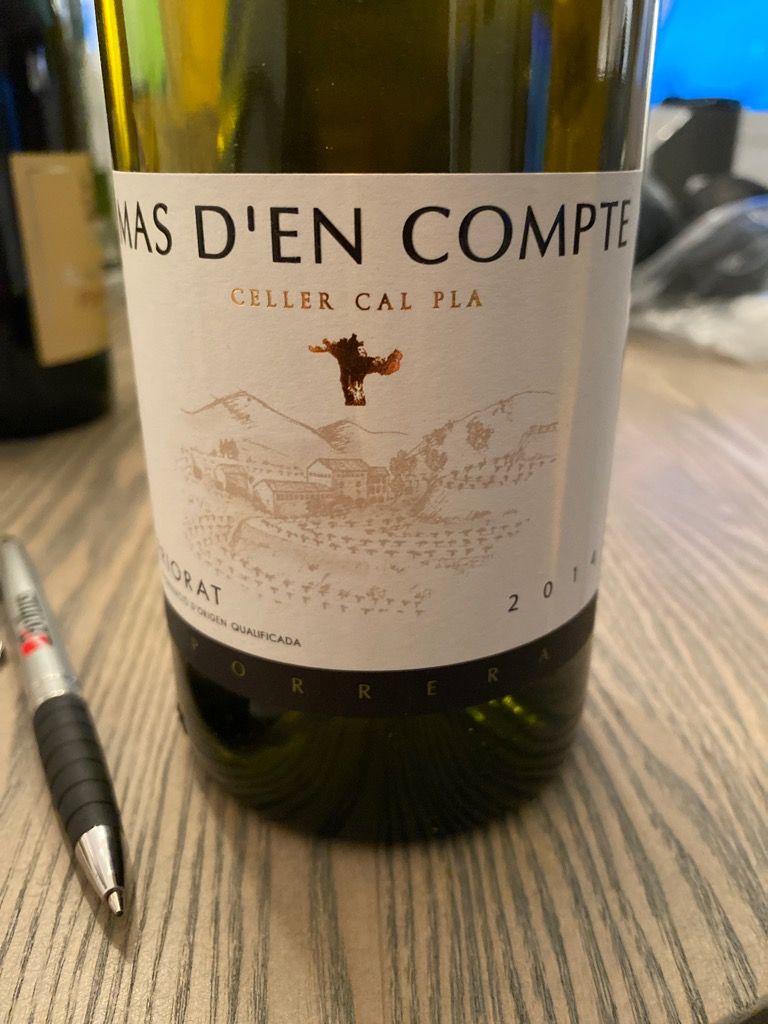
External search
Google (images)
Wine Advocate
Wine Spectator
Burghound
Wine-Searcher
Vintages
2019
2018
2017
2015
2014
2013
2012
2011
2010
2009
2008
2007
2006
2004
2001
From this producer
Show all wines
All tasting notes
|
| Drinking Windows and Values |
| Drinking window: Drink between 2012 and 2015 (based on 6 user opinions) |
| Community Tasting History |
| Celler Cal Pla Producer website
One of the oldest grape-growing families in the Priorat, the Sangenis family had historically sold the entirety of their production to the local coop until 1995 when they formed a new company, Mas d'en Compte, to bottle wine under their own name.
Now, young Joan Sangenis manages the estate and makes the wines and has converted the entire estate away from chemical pesticides and herbicides."
"In a region where almost everyone has a few vines over 50 years old, the Sangenis family’s entire vineyard is practically this old, with several small parcels of 100+ year old vines of Grenache and Carignan. Also, they are one of the few holders of extremely old vine white Grenache, a varietal that many properties have ripped out. This old vine material means that yields are extremely low and concentration quite high." -Importer
U.S. Importer (BEST source of addt'l info?)White Blend"White blend" means the wine is made from a blend of two or more different white varieties - or in some cases a blend of pink or red varieties that are vinified white, ie. without any skin contact.
A blend of Antao, Arinto, Rouperio. Spain Vinos de España - Wines of Spain (Instituto Español de Comercio Exterior) | Wikipedia
Wine Map on weinlagen-info
Spain is the third largest wine producing nation in the world, occupying the majority of the Iberian Peninsula with vast diversity in climate, culture, and of course, wine. From inky, dark reds of the [Priorat] to dry, white Finos from Andalusia, Spain can easily boast of elaborating a wide variety of notable styles. Within Spain there are currently 62 demarcated wine regions, of which a handful have gained international recognition: [Rioja], Priorat and [Ribera del Duero]. Yet these regions are only a small sample of the high quality wines Spain produces. Regions such as Cava, Penedes, Somontano, Galicia, Rueda and Jerez are only a few of the numerous regions worthy of exploration throughout Spain. Spain can also lay claim to having the most land under vine in the world, growing up to, by some accounts, 600 indigenous varietals of which Tempranillo is their most well known. Other popular varietals include [Garnacha], Bobal and Monastrell for reds and for whites; the infamous [sic] Palomino Fino grape which is used in the production of sherry wine, Pedro Ximenez in Montilla Morilles, Albarino used in the creation of the bright, effervescent wines of Galicia, and Verdejo in Rueda. - Source: - Catavino.net
Spain is not in the forefront of winemaking for its dessert wines, other than for its sweet wines from Sherry country including the highly revered Olorosos (when sweetened). But apart from Sherry Spain has a range of styles of dessert wines, ranging from the those made from the Pedro Ximenez grape primarily in Jerez and Montilla-Moriles) to luscious, red dessert wines made in the Mediterranean from the Garnacha (Grenache) grape. Some good Moscatels are made in Mallorca, Alicante and Navarre. The northwest corner of Spain, Galicia, with its bitter Atlantic climate, is even making dessert wines, called “Tostadillos” in the village of Ribadivia (similar to France’s “Vin de Paille”). The Canary Islands have made interesting dessert wines for centuries (they are mentioned by Shakespeare, for example) and in recent years the quality of winemaking has been improved and the Canary Islands wines are being better marketed now. The winemaking styles for “Vinos Dulces” are also diverse, from “Late Harvest” (Vendimia Tardía) to “Fortified Wines” (Fermentación Parcial). Based on in-spain.info.Catalunya Map on weinlagen-infoPrioratAbout 100 kilometers from Barcelona, Priorat originated as a distinct recognized wine region in 1932, and was approved in 1954.
|
|




